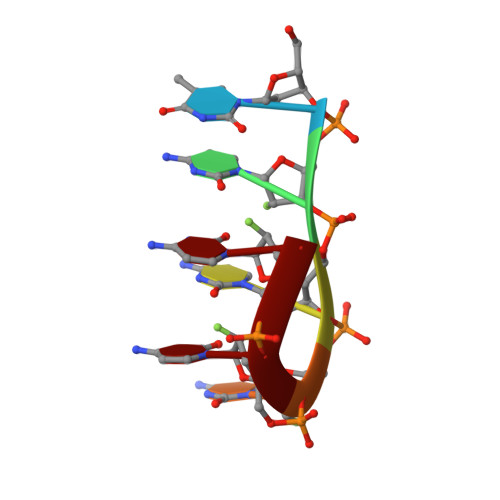i-Motif folding intermediates with zero-nucleotide loops are trapped by 2'-fluoroarabinocytidine via F···H and O···H hydrogen bonds.
El-Khoury, R., Macaluso, V., Hennecker, C., Mittermaier, A.K., Orozco, M., Gonzalez, C., Garavis, M., Damha, M.J.(2023) Commun Chem 6: 31-31
- PubMed: 36797370
- DOI: https://doi.org/10.1038/s42004-023-00831-7
- Primary Citation of Related Structures:
7ZYX - PubMed Abstract:
G-quadruplex and i-motif nucleic acid structures are believed to fold through kinetic partitioning mechanisms. Such mechanisms explain the structural heterogeneity of G-quadruplex metastable intermediates which have been extensively reported. On the other hand, i-motif folding is regarded as predictable, and research on alternative i-motif folds is limited. While TC 5 normally folds into a stable tetrameric i-motif in solution, we report that 2'-deoxy-2'-fluoroarabinocytidine (araF-C) substitutions can prompt TC 5 to form an off-pathway and kinetically-trapped dimeric i-motif, thereby expanding the scope of i-motif folding landscapes. This i-motif is formed by two strands, associated head-to-head, and featuring zero-nucleotide loops which have not been previously observed. Through spectroscopic and computational analyses, we also establish that the dimeric i-motif is stabilized by fluorine and non-fluorine hydrogen bonds, thereby explaining the superlative stability of araF-C modified i-motifs. Comparative experimental findings suggest that the strength of these interactions depends on the flexible sugar pucker adopted by the araF-C residue. Overall, the findings reported here provide a new role for i-motifs in nanotechnology and also pose the question of whether unprecedented i-motif folds may exist in vivo.
Organizational Affiliation:
Department of Chemistry, McGill University, Montréal, H3A0B8, Canada.














